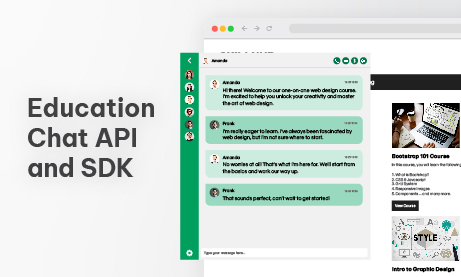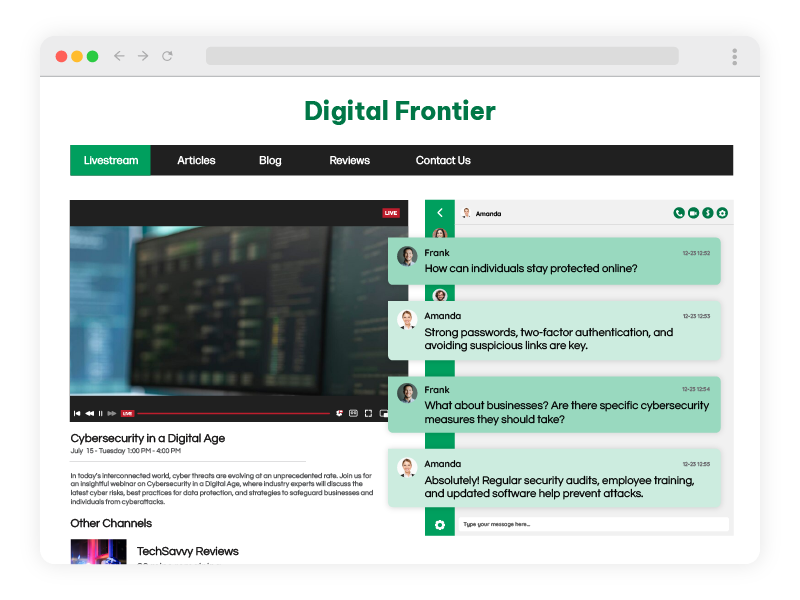Education has changed dramatically over the last decade. From K-12 schools and universities to online courses, tutoring platforms, and corporate training, learning is now everywhere, all the time. But what hasn’t changed is the need for interaction: Students learn best when they can communicate, ask questions, and collaborate.
This is where an education chat API and SDK steps in. By providing real-time, flexible, and secure chat, these tools empower students, teachers, and administrators alike. In this post, we’ll dive deep into what an education chat API and SDK is, why it’s essential, and how to get the most from it, with practical examples, technical insight, and actionable best practices.
What Is an Education Chat API and SDK?
Simply put, an education chat API and SDK is a set of tools for seamlessly adding chat capabilities to any learning environment.
– The API (Application Programming Interface) is a set of endpoints for programmatic management: create classrooms, users, messages, and more.
– The SDK (Software Development Kit) offers prebuilt widgets, UI components, and helper functions to make chat integration fast and reliable, even for complex educational use cases.
Whether you want a simple class Q&A box, group discussions, 1:1 private chats, or moderated webinars, an education chat API and SDK can handle it, all without building from scratch.
Why Use an Education Chat API and SDK?
Still unsure whether you need one? Here are the top reasons why.
Top Benefits for Education
– Instant Communication: Enables direct messaging between students, teachers, and admins.
– Collaboration: Supports group projects, peer review, and teamwork.
– Moderation: Keeps discussions safe and on-topic with admin tools.
– Accessibility: Works across devices: phones, tablets, laptops.
– Customizable: Tailor chat UI and roles to your brand and teaching style.
– Secure: Protects privacy and complies with educational standards.
Education chat API and SDK solutions are plug-and-play, yet endlessly adaptable, perfect for the fast-moving world of modern education.
Core Features of an Education Chat API and SDK
A great education chat API and SDK should offer the following:
– User Management: Enroll students, assign roles (student, teacher, TA, admin).
– Room Creation: Make group chats for classes, clubs, or tutoring sessions.
– Moderation Tools: Mute, ban, or approve messages and manage users.
– Persistent History: Let students review past discussions and resources.
– Auto-Login & SSO: Integrate with your existing authentication for seamless access.
– Integrations: Connect to LMS, grading systems, and notification platforms.
– Compliance: Meet privacy standards (FERPA, GDPR, COPPA, etc.).
Use Cases: How Education Chat API and SDK Transforms Learning
1. Virtual Classrooms
Real-time chat brings life to virtual classrooms. Teachers can answer questions, share resources, and manage discussions.
Example Integration:
```javascript
ChatSDK.init({
roomId: 'class-math-101',
user: { id: 'stu789', name: 'Ella S.', role: 'student' },
token: 'secureToken'
});
```
2. Group Projects & Study Rooms
Small group chats support teamwork and peer review. Create ad-hoc or scheduled study rooms.
Python Example:
```python
import requests
response = requests.post(
"https://api.educationchat.com/rooms",
headers={"Authorization": "Bearer API_KEY"},
json={
"name": "Group Project A",
"participants": ["stu123", "stu789", "stu456"],
"type": "private"
}
)
```
3. Office Hours and Q&A Sessions
Let students ask questions privately or in a moderated public forum. Enable teacher-moderated Q&A with approval controls.
4. Announcements and Broadcasts
Send announcements to all students or targeted groups (e.g., “Exam postponed to next Monday!”).
5. Parent-Teacher Communication
Create secure channels for parents to connect with teachers or school staff, all moderated and logged for transparency.
Technical Deep Dive
Let’s get technical; here’s how a typical education chat API and SDK works behind the scenes:
A. Authentication & User Sync
Integrate the chat platform with your existing user database or Single Sign-On (SSO) provider.
REST API Example: Generate a Login Token
```bash
curl -X POST https://api.educationchat.com/users/token -H "Authorization: Bearer API_KEY" -d '{"userId":"stu789","expiresIn":3600}'
```
B. Room Management
Create and manage chat rooms dynamically, link them to courses or sessions, and assign roles for moderation.
Room Update Example:
```python
requests.patch(
"https://api.educationchat.com/rooms/room-id",
headers={"Authorization": "Bearer API_KEY"},
json={"name": "Updated Room Name", "theme": "science"}
)
```
C. Embedding the Chat Widget
The SDK lets you add the chat UI directly to your platform with a snippet of code.
Widget Integration Example:
```html
<div id="edu-chat"></div>
<script>
ChatSDK.render({
container: "#edu-chat",
roomId: "bio-2025",
user: { name: "Dr. Chen", role: "teacher" },
theme: "education"
});
</script>
```
D. Moderation and Analytics
Track and manage messages, ban users, and generate chat usage reports for compliance and improvement.
Must-Have Features for an Education Chat API and SDK
– Role-based access (student, teacher, admin)
– Private and public rooms
– Persistent message history
– Auto-login / SSO integration
– Moderation dashboard
– File, image, and media sharing
– Mobile and desktop support
– Rich message formatting (math, code, links)
– Accessible UI (for all users, including those with disabilities)
– Compliance-ready logging
Best Practices for Deploying Education Chat API and SDK
1. Start with Security: Use tokens, encrypted connections, and permission controls.
2. Integrate with Your LMS: Sync users and courses for frictionless access.
3. Enable Moderation: Equip teachers with easy tools to keep chat safe and constructive.
4. Design for Mobile: Ensure chat is usable on phones and tablets.
5. Archive Everything: Keep message logs for review and compliance.
6. Test at Scale: Simulate class sizes to guarantee performance.
7. Customize the Experience: Match your institution’s brand and learning culture.
8. Train Your Staff: Provide guides or workshops for effective chat use.
9. Solicit Feedback: Continuously improve based on student and teacher input.
Industry Spotlight: Real-World Scenarios
Here’s where you can use an education chat API and SDK.
A. K-12 Schools
– Classroom chat for remote and hybrid learning
– After-school club rooms
– Teacher-parent communication
B. Higher Education
– Departmental forums and research groups
– Virtual office hours for professors
– Live Q&A during lectures or webinars
C. EdTech Platforms
– Peer tutoring chatrooms
– Automated study bots and FAQ
– Integrations with assessment and grading tools
D. Corporate Training
– Cohort discussions
– Feedback channels during live sessions
– Onboarding Q&A for new hires
Integrating an Education Chat API and SDK: Step-by-Step Guide
Follow these steps to setup your chat:
1. Sign up for a provider
Choose a chat provider with robust Education Chat API and SDK offerings.
2. Obtain API credentials
Secure your keys and access tokens from your dashboard.
3. Set up user authentication
Integrate your login system or SSO for seamless access.
4. Create rooms programmatically
Use the API to spin up class, group, or event chat rooms.
5. Embed the chat widget
Add the SDK code snippet to your courseware or site.
6. Customize roles and permissions
Configure who can moderate, post, and access rooms.
7. Enable file and media sharing
Let users exchange study materials and resources.
8. Activate moderation tools
Set up rules, ban lists, and moderation dashboards.
9. Test and deploy
Trial your integration with a pilot class or group, then roll out broadly.
Example Workflows and Code Snippets
A. Student Auto-Login with SSO
```javascript
ChatSDK.init({
roomId: 'bio-2025',
user: {
id: 'stu001',
name: 'Liam P.',
email: 'liamp@example.edu'
},
token: 'autoLoginToken'
});
```
B. Assigning a Teacher as Moderator
```python
requests.post(
"https://api.educationchat.com/rooms/room-id/moderators",
headers={"Authorization": "Bearer API_KEY"},
json={"userId": "teacher456"}
)
```
C. Enabling File Sharing in Chat
```bash
curl -X PATCH https://api.educationchat.com/rooms/room-id -H "Authorization: Bearer API_KEY" -d '{"fileSharing":true}'
```
Advanced Use Cases
If you’re still looking for other use cases for your chat, here are some examples:
– AI-based tutoring chatbots
– Real-time polling and quizzes
– Integration with video conferencing
– Anonymous feedback channels
– Scheduled chat rooms for timed exams
– Parent access with restricted permissions
– Data export for learning analytics
– Multilingual support for international students
Troubleshooting & Tips
– If students can’t see messages, check user roles and permissions.
– For compliance, enable detailed logging and set up retention policies.
– For large webinars, limit chat posting to reduce spam and enable moderation queues.
– To prevent distraction, use “announcement only” rooms for teachers/admins.
– Customize chat appearance to support dark mode and accessible color schemes.
The Future of Digital Learning Is Interactive
Learning is no longer confined to the classroom, nor to rigid schedules. With the right education chat API and SDK, you can create vibrant, safe, and interactive digital spaces for your students, teachers, and communities. Whether you’re building a remote classroom, an EdTech app, or a new virtual campus, chat is the bridge that connects learners and educators in real time.
Embrace the future of education. Foster engagement, streamline collaboration, and unlock the potential of every learner. Start with an education chat API and SDK and see how far your educational community can go.
Ready to integrate?
Dive into the SDK and API documentation of your chosen chat provider, try out the examples above, and empower your students to connect, learn, and succeed, wherever they are.




